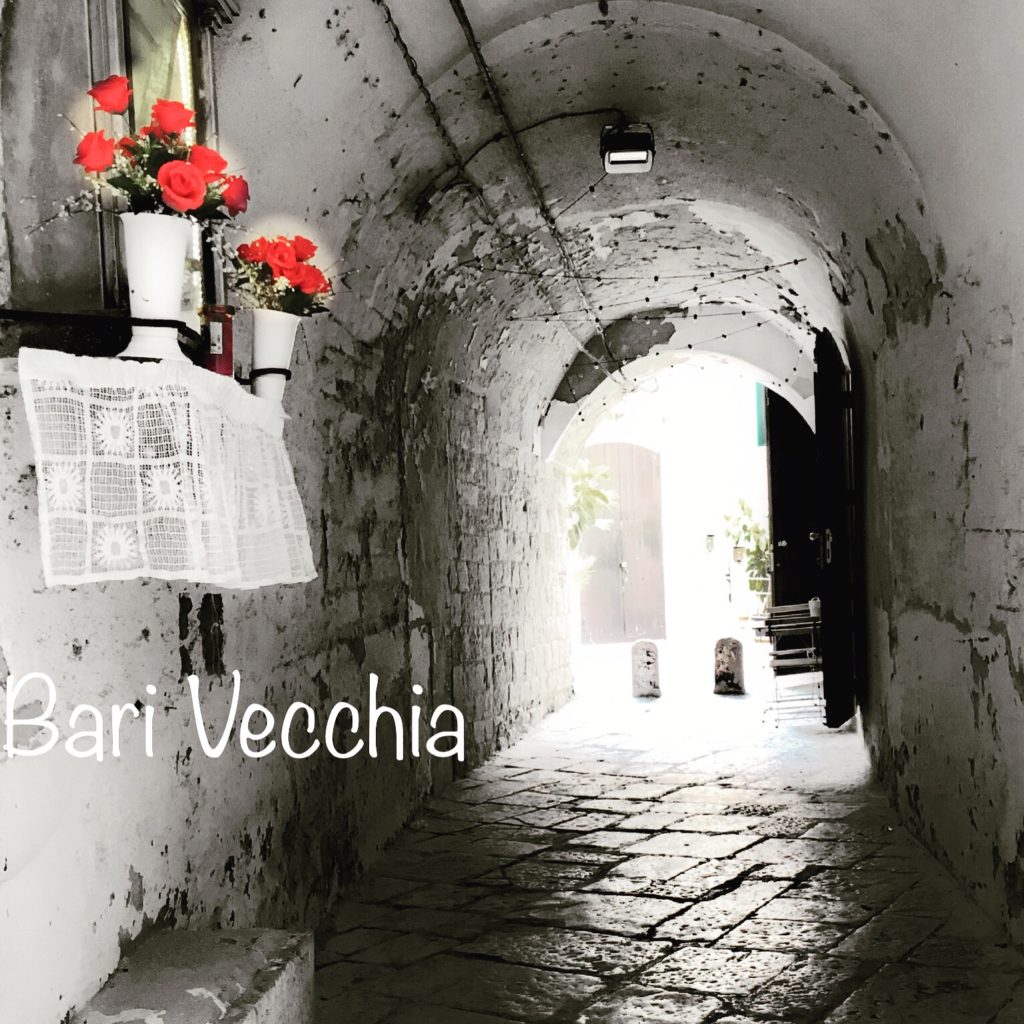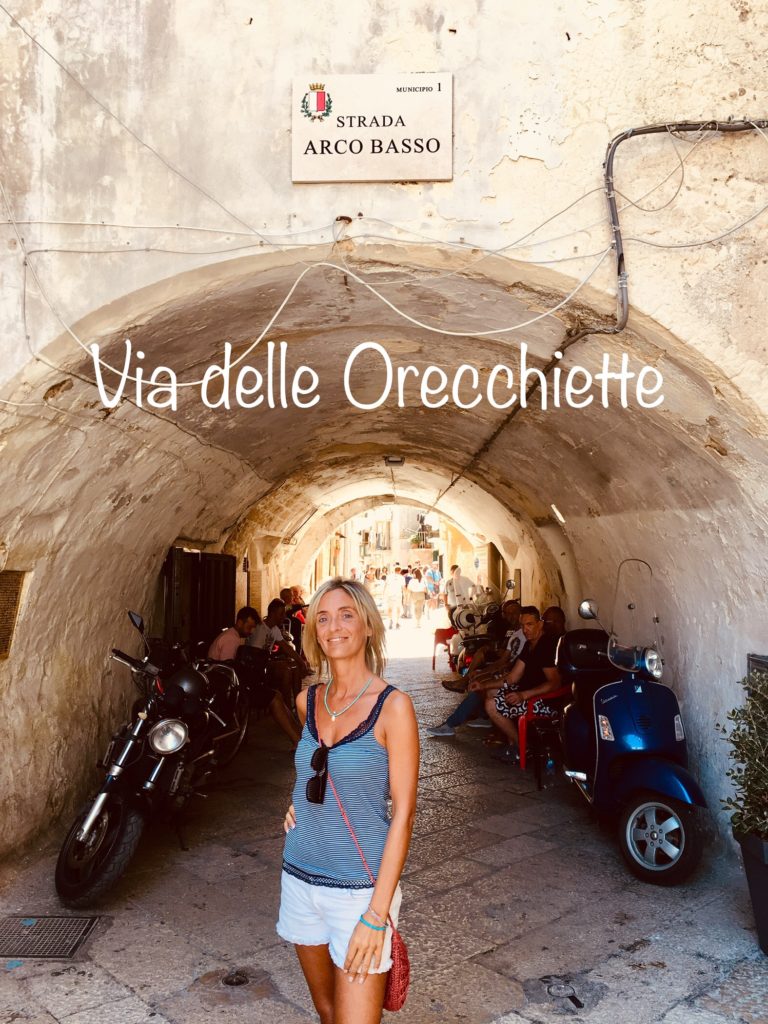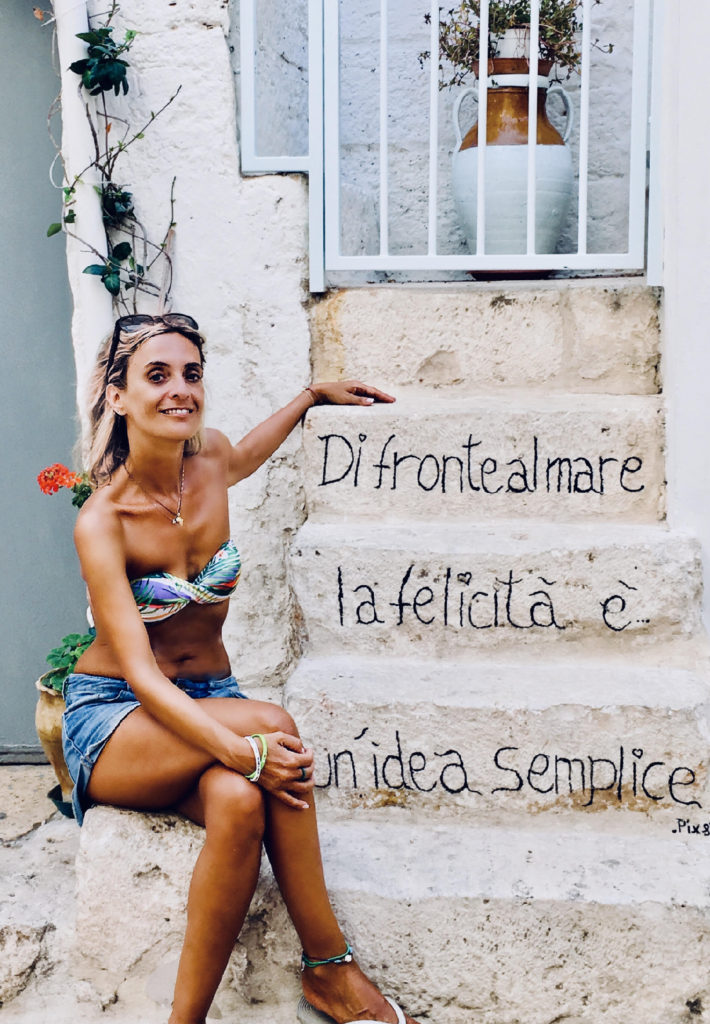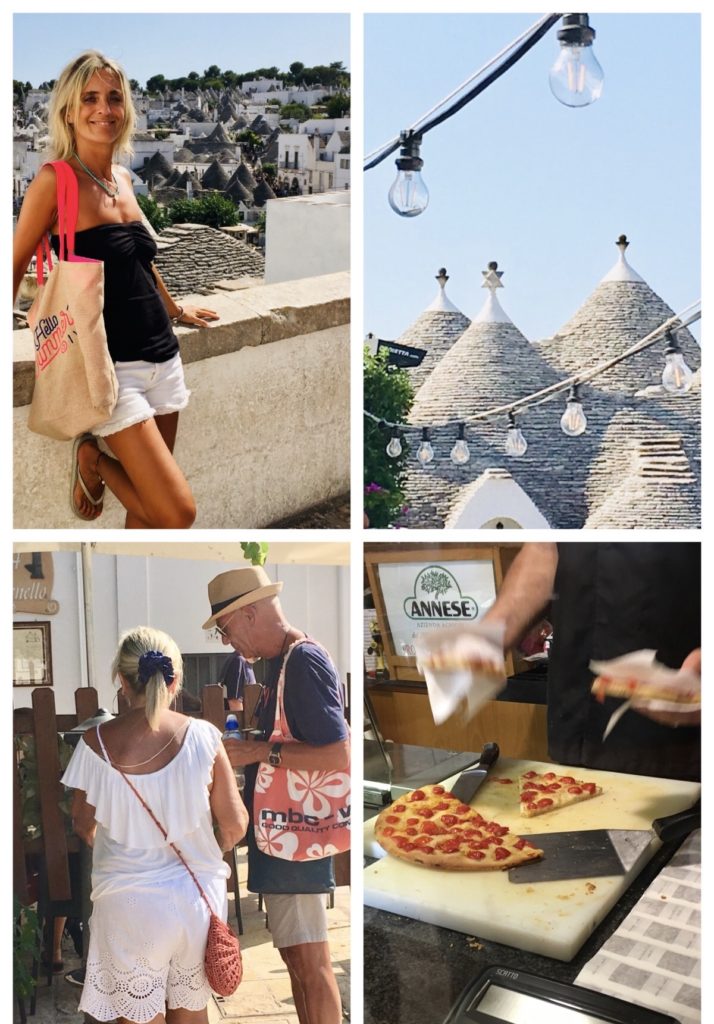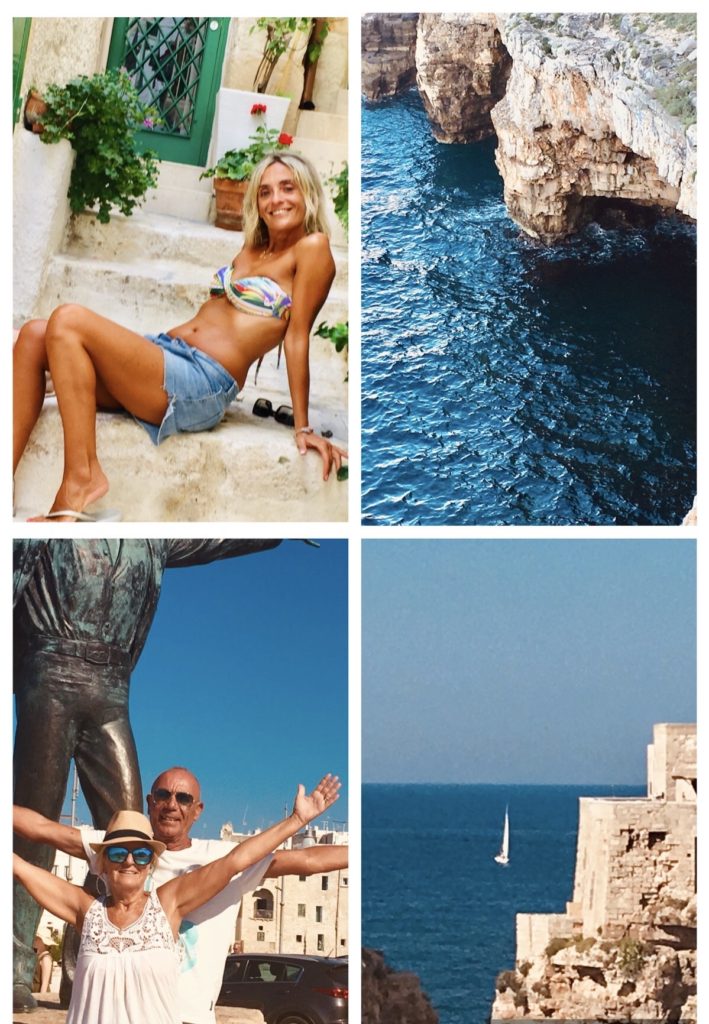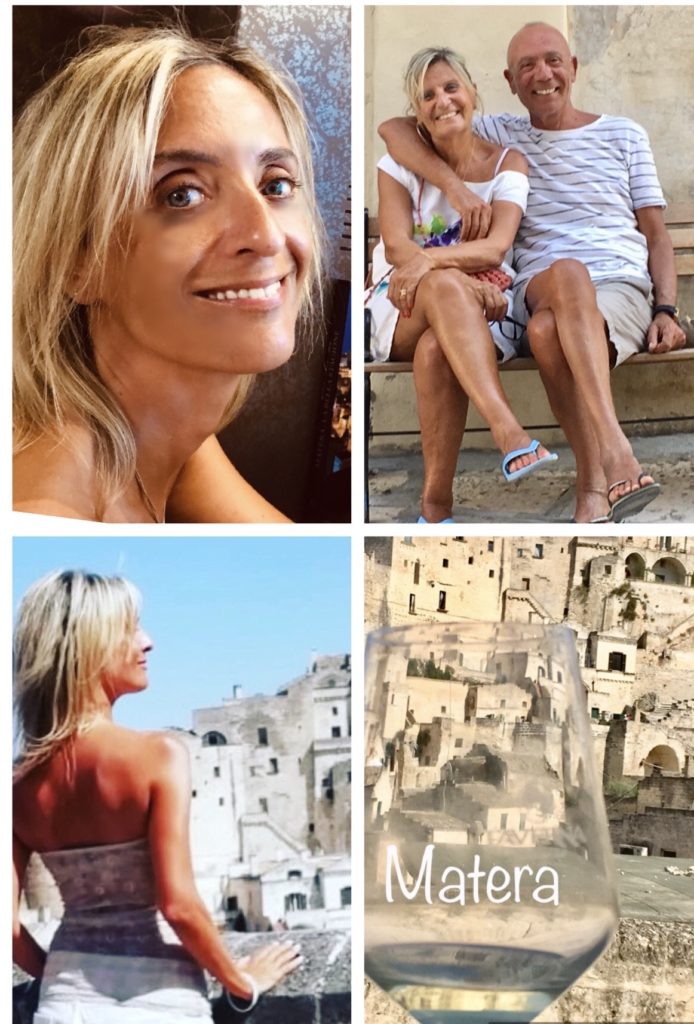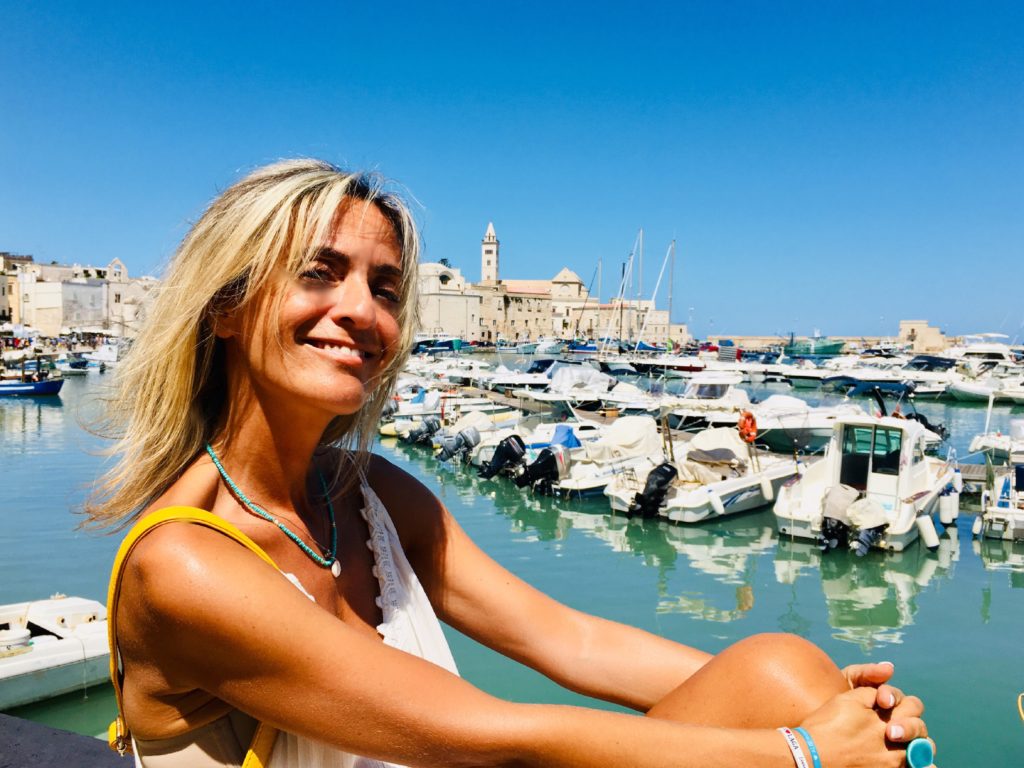“…Notte, spiaggia, Mare caldo, Luna bassa
Dà onda giallaaaa, Bagno di maree, A mezzanottee
Scif sciaf sotto la luna
A quest′ora più nessuno, Sulla spiaggia sta a guardare, Siamo soli mezzo al mare
A mezzanotte…”
‘Masseria Monache’, un viaggio nel magico Salento
Un weekend di Febbraio sono ospite di Alberto Argentieri presso la sua ‘Masseria Monache’ . Questo è un incantevole chateaux cinque stelle a San Pietro Vernotico, vicino Brindisi . Non finirò mai di ringraziare Luigi Bressan, noto enogastronomo televisivo, per avermi fornito il prezioso contatto!
In tre giorni Alberto mi aiuta realizzare un sogno! Quale? Quello di scoprire il fantastico universo delle masserie in Puglia, di cui vi parlerò più avanti nell’articolo. Inoltre questo brillante ragazzo pugliese mi farà girare la provincia di Brindisi. Mi svelerà i tesori nascosti del tacco del nostro stivale!
Allora siete pronti? Prendete appunti , perché sono sicura che la ‘Masseria Monache sarà la vostra prossima scelta per una vacanza alternativa al Sud tra gli uliveti e le acque limpide della Puglia. Sono sicura che potrebbe essere la vostra prossima tappa per una vacanza indimenticabile!
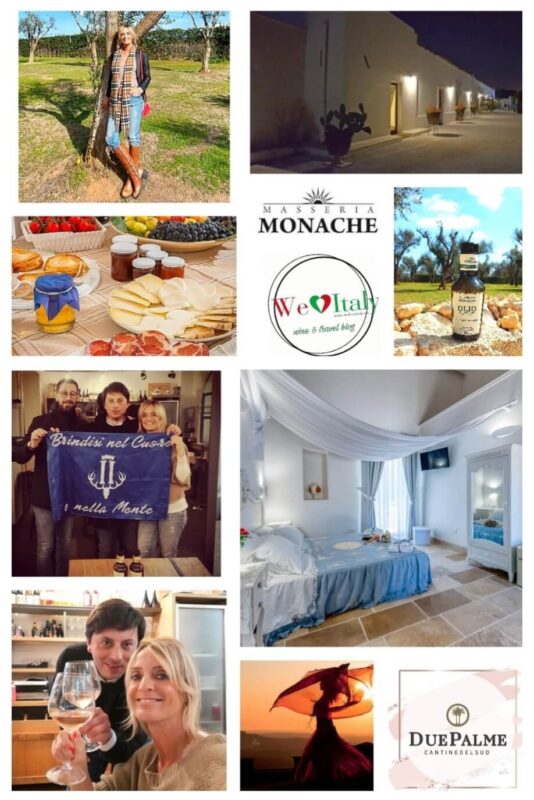
Si parte! San Pietro Vernotico. La provincia di Brindisi
Fortunatamente la mia avventura fuori porta comincia un venerdì pomeriggio! Lasciata ‘Piazza Duomo’ a Brindisi , vado in macchina con Alberto alla volta di San Pietro Vernotico! Tanto per cominciare, durante il tragitto Alberto precisa che San Pietro Vernotico è il suo paese natale. Ma è anche quello del grande Modugno. Pare che qui ‘Mr Volare’ trascorse sia la sua infanzia, che la sua adolescenza!
Cena gourmet al ‘Prato Bistrot’
Intanto cala il buio, e con essa anche la temperatura! Non è difficile trovare parcheggio a San Pietro Vernotico, un piccolo comune di appena 13, 000 abitanti! Scesi dall’auto ci avviamo a cenare presso il ‘Prato Bistrot’ , rinomato ristorante del suo amico Pier Paolo Prato !
Gentilmente Pier Paolo , ci fa accomodare in un tavolo per due. Ci offre delle bollicine di benvenuto. Prima di ordinare Alberto mi fa inzuppare il pane nel suo olio extravergine firmato ‘Masseria Monache’! Che bontà! Una linea aromatizzata al limone, basilico, arancia e peperoncino!
Menù da re al ‘Prato Bistrot’!
Ed ecco che il lauto banchetto si arricchisce di cruditè di spada, tonno , ostriche, e linguine ai ricci! Non c’è da stupirsi se il pesce è freschissimo ! Il ‘Prato Bistrot’ puo’ contare infatti sulla pescheria di famiglia . Figuratevi, che prima esso era solo un bar , oggi invece è fiore all’occhiello della ristorazione locale,
In zona c’è solo Pier Paolo , che riesce a esplodere ad alti livelli! D’altronde. Non è un caseo se Pier Paolo è da poco presidente neoeletto della ‘F.I.P.E.’ (‘Federazione Italiana Pubblici Esercizi di Brindisi’). Ci hanno visto bene! Purtroppo Pier Paolo va via perché indaffarato con altri clienti.
Si torna a al capoluogo! A concludere splendidamente la serata, io e Alberto ci concediamo un amaro al ‘Palazzo Nervegna’ . In questa dimora storica dorme il capitello della colonna romana di Brindisi!
La costa brindisina. Un tour tra Ionio e Adriatico!
Mamma mia! Un po’ di sole! Spalanco le finestre del mio ‘b&b Acquapazza’ nel cuore di Brindisi, e respiro l’aria fresca del mattino. Davanti i miei occhi la cupola della cattedrale, che maiolicata fa da faro a dei gabbiani giganteschi.
Come da rito, mi fiondo a rifare colazione con caffè nero e pasticciotto pugliese! Questo goloso dolce di frolla ripieno di crema, varrebbe da solo una valida ragione per recarsi in Puglia! Una goduria infinita! Mi rilasso mentre aspetto Alberto . Si fa tardi e ora di andare via! C’è troppo da vedere e da fare! Alberto mi fa salire nel suo fuoristrada per andare a contemplare il mare del Salento! Vediamo tre posti da girare , seguitemi!
1. ‘Campo di mare’
‘Campo di mare’ è un suggestivo borgo di pescatori del comune di Torchiarolo. Questa è meta ambita principalmente dalle famiglie locali. La spiaggia è eccezionale nei giorni in cui spira il vento di tramontana! Il fondale a riva è basso e sabbioso, ideale per lasciare giocare i bambini in tranquillità!
2. ‘Torre San Gennaro’
‘Torre San Gennaro’ si affaccia sull’azzurro dell’Adriatico. Questa oasi è piena di attrezzatissimi stabilimenti balneari, costellati da tipici chioschetti in cui trovare ristoro alla calura estiva. E in uno di questi io e Alberto ci concediamo due Negroni.
Siamo al ‘Bar Nautico’ . Nel frattempo che Alberto esce a fumare, chiacchiero del più e del meno con Salvatore Paladini , il proprietario . Che coincidenza! In precedenza questo simpatico signore era cantiere a Montevarchi! Ci accomuna la passione per il vino e per la Toscana! Ci concediamo da Salvatore per dirigerci verso ‘Masseria Monache’.
3. ‘Parco del Negroamaro’
Inevitabilmente il tratto di strada che porta da Brindisi verso San Pietro Vernotico cambia decisamente. Si colora di un verde sgargiante. Stiamo percorrendo la pianura del ‘Tavoliere del Salento’ . Davanti a noi si staglia il ‘Parco del Negroamaro’, una distesa di filari infiniti destinati alla lavorazione del famoso vino del Negroamaro.
Il Negroamaro è un vitigno autoctono a bacca rossa del Salento! Il nome Negroamaro fa riferimento al colore scuro delle uve. Probabilmente l’etimo deriverebbe dalla parola ‘nero’ dal greco ‘μαύρο’ o dal latino ‘niger’ (o da tutte e due!). Questo nettare divino è tra i rossi più corposi e pregiati d’Italia. Dove cresce il Negroamaro i suoli sono fertili e il clima mite, specie a Squinzano e Salice Salentino, le due aree ‘DOC’ !
‘Masseria Monache’, la tipica masseria del Salento
Si supera il ‘Parco del Negroamaro’, e Alberto svolta verso un vialetto in Strada Provinciale 86 a San Pietro Vernotico. Eccoci finalmente ‘Masseria Monache’! Un resort incantato immerso nel favoloso Salento, circondato dalla macchia mediterranea. L’ideale per svagarsi all’insegna del benessere, del relax, e del divertimento.
Con mia grande gioia, si apre un cancello enorme che ci fa entrare dentro la ‘Masseria Monache’. All’istante quello che mi colpisce di questo eden incantato sono le magnifiche mura in tufo e la vastità della sua superficie . E ancora il contrasto tra il bianco della pietra leccese che l’avvolge e il blu cobalto del cielo!
Senza parole! ‘Masseria Monache’ è un gioiello incastonato in due ettari di terra, con altri 10.000 disseminati nelle vicinanze. Un giardino grandioso che alterna palme esotiche, ad orti, agrumeti e 150 ulivi, da cui producono il loro pluripremiato extravergine.
Mi rendo conto che soggiornare presso la ‘Masseria Monache’ equivale a ritornare al lusso e alla semplicità delle piccole cose. Questi erano i veri valori della vecchia vita contadina, che sta alla base della storia di questo straordinario relais !
Nel dettaglio la Masseria Monache’ consta di due edifici. Il primo color rosso porpora era l’ex casa padronale, dove vive Alberto insieme ai suoi affetti. Il secondo color latte , era un vecchio deposito che ora fa da bed and breakfast. Ci sono quattro stanze in tutto. Queste sono sovrastate dai caratteristici tetti alti con volte a botta, e sono dotate di tutti i comforts. Gli arredamenti interni sono lineari e di classe. Ma cerchiamo di capire un po’ di più sulle masserie !
Come nascono le masserie? Un pezzo di storia del Sud Italia
Dunque, le masserie erano degli edifici rurali risalenti al Cinquecento, che facevano parte di vere e proprie aziende agricole all’ epoca del latifondo. Ognuna di queste costruzioni in mattoni svolgeva un ruolo diverso.
Il fenomeno delle masserie esplode in tutto il Meridione durante il regno dei ‘Borbone’ (XVII sec.). A seguito dell’espropriazione dei feudi ecclesiastici, i re spartirono i lotti di terra ai ‘massari’, cioè ‘capi reggenti’. Un escamotage per controllare l’operato dei contadini e al contempo per approvvigionarsi di cereali.
Il picco dell’evoluzione delle masserie si ebbe nel periodo del ‘Regno delle Due Sicilie’ (XVIIII). Allora si avvertì ulteriormente l’esigenza di favorire questo tipo di comunità agricole per il ripopolamento di aree desolate.
Cosa sono allora le masserie?
In buona sostanza, le masserie erano dei veri e propri villaggi agricoli, che comprendevano, oltre alla dimora del proprietario terriero, anche gli alloggi dei contadini, le stalle, i cortili e le aree di lavoro. Non a caso il termine deriva dalla parola ‘masserizie’, cioè oggetti e viveri di qualsiasi uso quotidiano riposti nei vari in spazi loro destinati.
A seconda della ricchezza dei proprietari, queste imprese agricole erano più o meno sfarzose. Se c’era qualche stemma in più, le masserie erano anche fortificate. C’erano al loro interno cinta murarie e torri per difendersi dapprima dai Mori e briganti, e di poi da ladri comuni
Il lento decadimento delle masserie è da attribuire alla ‘riforma agraria’ a cavallo delle due guerre mondiali. Normalmente quando le terre furono frazionate, si spense per sempre il senso di aggregazione di queste realtà bucoliche! Il loro conseguente abbandono fu rapido. Ma non tutto andò perduto!
Come rinascono le masserie? Ve lo spiego nel dettaglio con la storia di Alberto!
Solo recentemente le masserie sopravvissute hanno cambiato look e funzionalità. Tutto questo grazie allo spirito d’iniziativa di privati che le hanno destinate a b&b, agriturismi, e relais, per la gioia dei vacanzieri!
Ne è un esempio la ‘Masseria Monache’ di Alberto , una proprietà che ereditò dai genitori . Originariamente non era altro che un rudere. Questo era appartenuto prima a un convento, dopo a ‘Don Zonda’ , un nobile milanese che vi ci fece la sua residenza nobiliare!
Certamente per Alberto ‘Masseria Monache’ è una benedizione. Ma dieci anni di attività di successo hanno richiesto coraggio, impegno, costanza e determinazione! Vecchie foto dell’immobile fanno capire che la ‘Masseria Monache’ era proprio una catapecchia! Più facile forse a vendersi che a ristrutturare! Tuttavia la passione per la propria terra e l’attaccamento alle proprie radici hanno spinto Alberto a rischiare, e l’audacia l’ha abbondantemente premiato!
Perché allora andare alla ‘Masseria Monache’.
Capirete bene che ‘Masseria Monache’ è il posto ideale dove rifugiarsi per una villeggiatura all’insegna del benessere! Alla ‘Masseria Monache’ non dovete preoccuparvi di nulla! A coccolarvi ci pensa Alberto e il suo staff ! Al resto provvede madre natura! Immaginatevi di svegliarvi e oziare tra le aperte campagne pugliesi al cra cra cra dei grilli e delle cicale e a sentirvi parte del Creato!
E se non siete troppo pigri potete noleggiare bici, o partecipare alle escursioni a cavallo organizzate apposta per farvi esplorare i dintorni! E tanto altro ancora! Non siete ancora cora convinti ? Seguitemi!
5 buoni motivi per prenotare alla ‘Masseria Monache’!
- se non sapete come fare per piombare alla ‘Masseria Monache’ , avete a disposizione un servizio di transfer con tanto di navetta dall’aeroporto ‘Papola Casale’ di Brindisi (26 km);
- Se siete auto muniti, potete contare sulla presenza di un ampio parcheggio sorvegliato h24!;
- Vi attende un’abbondante colazione biologica a buffet inclusa nel prezzo (su richiesta anche gluten/lactose free!)
- La mamma di Alberto vi farà assaporare i succulenti piatti della tradizione gastronomica salentina a base delle loro verdure e frutta di stagione;
- Alberto è un sommelier d’olio. Vi farà tastare quello che si spreme nei suoi uliveti. Un olio che ha vinto molti premi e che esportano in tutto il mondo!
- Riserva naturale di ‘Torre Guaceto’ ;
- Parco regionale di ‘Porto Selvaggio’;
- Oasi protettiva del WWW ‘Cesine’;
- Località balneari di ‘Lendinuso’ e ‘Casabalate’;
- Lecce ;
- Otranto;
‘Cantina due Palme’, una tentazione divina a Cellino San Marco
Per aggiungere un’altra tentazione alla lista delle cose da fare alla ‘Masseria Monache’ , vi suggerisco un salto a Cellino San Marco. Non per ascoltare Albano Carrisi, ma per tuffarvi nei vini del Salento!
Prima di ritornare a Pisa, Alberto mi porta presso lo show room delle ‘Cantina Due Palme’. Si tratta di un grandissimo stabile di 45.000 m² . Qui si svolgono tutti i processi di vinificazione, invecchiamento, imbottigliamento, e stoccaggio dei vini.
I vitigni del Salento
‘Cantine Due Palme’ è una cooperativa di 1000 affiliati delle migliori imprese vitivinicole tra Lecce, Brindisi e Taranto. Dal 1989, anno della sua fondazione a opera di Antonio Maci, l’obiettivo aziendale è la realizzazione di vini di qualità. Vini ottenuti esclusivamente da uve locali oltre il Negroamaro, quali:
Con una produzione di 18.000 bottiglie annue, proiettate quasi tutte nel mercato internazionale, ‘‘Cantina Due Palme’’ rappresenta veramente l’eccellenza dell’enologia pugliese.
I vini della ‘Cantina due Palme’
Luigi Fortunato è il direttore vendite dello show room . Ci fa da cicerone in questa cattedrale del vino, perno su cui gira tutto l’indotto economico dell’interland. A celebrare il mio rientro a Pisa, stappiamo i sugheri delle etichette migliori della ‘Cantina Due Palme’ :
- ‘1030 Millesimato’ : questo spumante è un Metodo classico di Negroamaro. Il suo è colore giallo paglierino, e ha profumi delicati di crosta di pane. Al naso prevalgono le sensazioni floreali con caratteristiche note fruttate. Al palato è pieno, sapido ed equilibrato, con una nota acidula. Il perlage è fine e persistente.
- ‘Core Rosa Rosato IGP’: ‘Corerosa’ come ‘cuore rosa’ dal dialetto salentino, a significare l’amore per i rosati tipica della Puglia a partire dal celebre ‘Five Roses’ ! Un rosé di Primitivo e Susumaniello che si fa ricordare! Il suo colore è rosa cerasuolo brillante. Esso presenta un profumo di amarena, ciliegia e lampone. Al gusto risulta sapido ed equilibrato, con una spiccata acidità che ne esalta la freschezza.
Grazie Alberto. Il Salento nel cuore!
Per concludere, voglio ricordarvi che alla ‘Masseria Monache’ l’ospitalità è disarmante, il contatto con la natura e la riscoperta delle tradizioni garantite! Sarà un’esperienza indimenticabile! Manca solo fare le valigie ! Non aspettate per forza l’alta stagione! Ogni giorno dell’anno è valido per fuggire dallo stress! Perché c’è sempre la ‘Masseria Monache’ che si prenderà cura di voi, viziandovi. Ve lo garantisco! Proprio come Alberto ha fatto con me!
Venire in Puglia vuol dire regalarvi benessere perché è una regione di grande tradizione enogastromica, ricca di storia e fascino . Che sia autunno, inverno, primavera o estate non mancheranno eventi, sagre, feste paesane e spettacoli nei quali rivivere le abitudini di un tempo e lasciarsi andare ai piaceri culinari. Cosa aspettate? Fate le valigie e partite! La Puglia vi aspetta!
If you like my post, please subscribe to the socials of www.WeLoveitaly.eu :





